Aphidiinae
The Aphidiinae are a subfamily of tiny parasitoid wasps that use aphids as their hosts. Several species have been used in biological control programs of various aphids.
| Aphidiinae | |
|---|---|
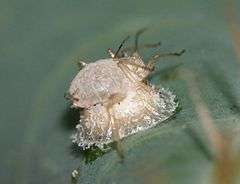 | |
| Praon cocoon below hollowed aphid | |
| Scientific classification | |
| Kingdom: | |
| Phylum: | |
| Class: | |
| Order: | |
| Suborder: | |
| Superfamily: | |
| Family: | |
| Subfamily: | Aphidiinae |
| Diversity | |
| c. 50 genera, 400 species | |
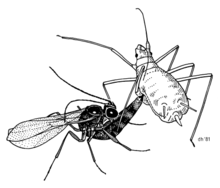
Biology and distribution
Aphidiines are koinobiont endoparasitoids of adult and immature aphids. While the larva of the 2–3 mm long Praon leaves the hollowed shell of the aphid from below to pupate in a volcano-like cocoon, most other Aphidiinae pupate inside the dead aphid and break out afterwards.
These wasps are found worldwide, but are primarily found in the northern hemisphere. Several species have been introduced to countries outside of their natural range, both accidentally and purposefully for biocontrol.[1]
Systematics
Although they have often been treated as a separate family, the Aphidiidae, the Aphidiinae are a lineage within the Braconidae. It is not yet clear to which braconid subfamilies they are most closely related.
| |||||||||||||||||||||
| Aphidiinae relationships (after Shi & Chen 2005) |
The Aphidiinae are subdivided into several tribes, the Ephedrini, Praini, Trioxini, Aclitini, and Aphidiini, with the latter subdivided into three subtribes.[2] Most species reside in the Aphidiini. The Praini's loss of internal pupation is likely to be secondary.[3]
Genera
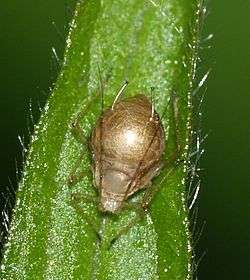
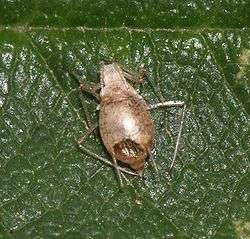
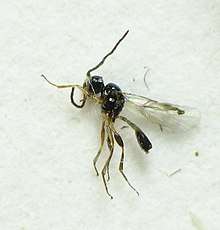
Ephedrini
- Ephedrus
- Toxares
Praini
- Praon
- Dyscritulus
- Harkeria
- Areopraon
Trioxini
- Trioxys
- Binodoxys
- Monoctonus
- Monoctonia
- Lipolexis
- Parabioxys
- Bioxys
Aclitini[4]
- Aclitus
Aphidiini
- Aphidius
- Diaeretiella
- Diaeretus
- Diaeretellus
- Lysaphidus
- Lysiphlebia
- Paralipsis
- Pauesia
- Protaphidius
- Pseudopauesia
- Adialytus
- Lysiphlebus
- Xenostigmus
See also
Footnotes
- Wharton, Robert A.; Marsh, Paul M.; Sharkey, Michael J. (1997). Manual of the New World Genera of the Family Braconidae (Hymenoptera) (PDF). Washington DC: The International Society of Hymenopterists. p. 69.
- Shi & Chen 2005
- Belshaw & Quicke 1997
- Žikić, et al. 2012
References
- Belshaw, R. & Quicke, D.L.J. (1997): A Molecular Phylogeny of the Aphidiinae (Hymenoptera: Braconidae). Molecular Phylogenetics and Evolution 7(3): 281-293. Abstract
- Shi, Min & Chen, Xue-Xin (2005): Molecular phylogeny of the Aphidiinae (Hymenoptera: Braconidae) based on DNA sequences of 16S rRNA, 18S rDNA and ATPase 6 genes. Eur. J. Entomol. 102: 133-138. PDF
- Žikić, V., Ilić, M., Stanković, S., Petrović, A., Petrović-Obradović, O., Kavallieratos, N. G., Starý, P., and Tomanović, Ž. (2012): Aphidiinae (Braconidae: Hymenoptera) of Serbia and Montenegro – tritrophic interactions. Acta Entomologica Serbica 17(1/2): 83-105.
External links
| Wikispecies has information related to Aphidiinae |
| Wikimedia Commons has media related to Aphidiinae. |
- BugGuide.net: Information and Pictures of Aphidiinae
- Cedar Creek: Picture of a Praon sp.
- brown citrus aphid parasitoid, Lipolexis scutellaris on the UF / IFAS Featured Creatures Web site